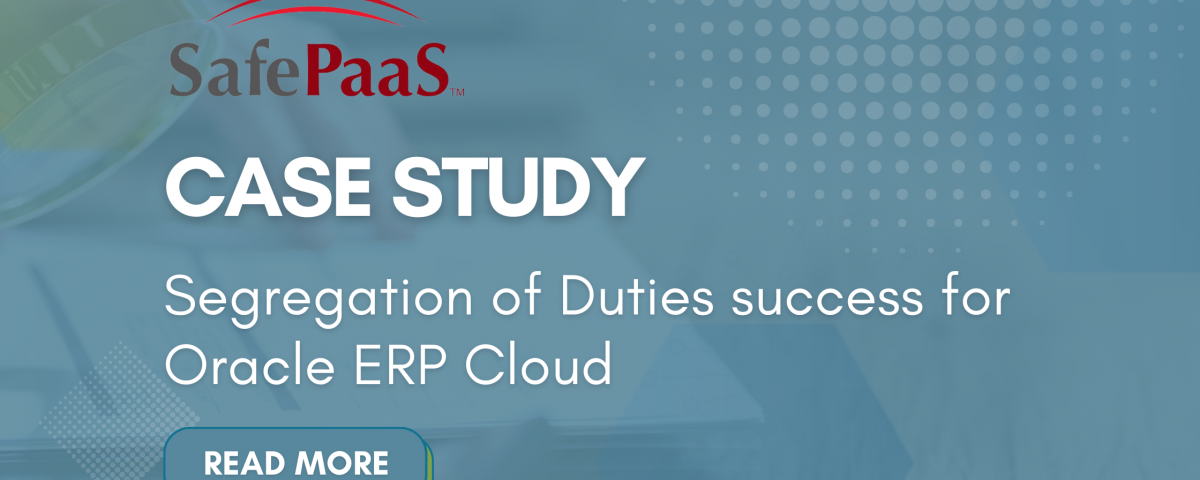Case Study Segregation of Duties Oracle ERP Cloud


Case Study: Achieving Segregation of Duties Success in Oracle ERP Cloud
Company type: Public
Industry: Fast food restaurants
Primary ERP system: Oracle ERP Cloud
The organization is a well-known fast-food chain that operates worldwide. To enhance Segregation of Duties (SoD) processes, the organization initiated a strategic effort to streamline compliance measures and minimize operational risks with SafePaaS. This initiative unfolded through a directed series of steps designed to promote alignment, reduce conflicts, and verify control effectiveness through robust audit analytics.
You can find a summarized version of the case study here:
The Challenges:
Like many organizations, the organization recognized the need to migrate their ERP systems to the cloud to remain competitive and agile in the digital era. In this case, from Oracle E-Business Suite to Oracle ERP Cloud. However, this transition posed unique challenges, especially regarding managing risk in a new operating model. Concerns arose regarding maintaining control and compliance standards in a cloud environment, particularly with the increasing prevalence of remote work and third-party involvement in IT and business functions.
Furthermore, the organization's extensive application landscape and reliance on platforms like ServiceNow and SailPoint added layers of complexity to the migration process. The traditional models that once worked well in on-premise environments were no longer sustainable or adequate for the cloud.
The organization also faced a major hurdle in demonstrating fine-grained segregation of duties, which required moving away from traditional role-based analyses. With the help of SafePaaS's automation and analytics capabilities, the organization was able to effectively segregate duties, maintain hierarchy within its Oracle Cloud ERP, streamline processes, and achieve operational goals.
The Solution:
The process of implementing a solution began with a meticulous selection of rules (or policies.) The organization worked in close collaboration with stakeholders from both compliance and IT teams to choose controls that aligned with enterprise-wide standards. This rule selection process helped the organization identify broader risks and compliance requirements. The teams consulted with other stakeholders to ensure that the selected controls met regulatory and operational standards.
Next, the organization conducted an analysis of its current Segregation of Duties controls and assessed its SoD maturity level. This thorough evaluation laid the groundwork for targeted risk mitigation strategies, enabling the organization to identify potential control gaps and inefficiencies.
After conducting the SoD analysis, the organization formed a team of Role Owners responsible for the selected internal controls chosen by the Rule owners. The Role Owner team was tasked with conducting a comprehensive review of the organization's operations to assess security contexts and privileges. This inclusive review process helped ensure a thorough assessment and bolstered the organization's compliance assurance efforts.
To tackle the challenge of False Positives, the organization employed sophisticated logic and rule-building techniques to minimize inaccuracies in compliance assessments. This meticulous approach guaranteed that implemented controls were effective and precise in identifying and correcting SoD control violations.
The organization also implemented compensating controls to effectively address SoD conflicts, particularly in areas where overprivileged users and service accounts posed significant threats. The organization managed control challenges confidently and efficiently by implementing strong monitoring tools and compensating controls.
Subsequent corrective actions were seamlessly processed by integrating the organization's IT Service Management system, ServiceNow, with SafePaaS, enabling quick and effective remediation of identified compliance discrepancies. This integrated processing of violations and remediations ensured compliance efforts aligned with operational realities, promoting a culture of continuous improvement.
Once the corrective actions were made, the organization granted auditors access to advanced audit analytics within SafePaaS to verify compliance work and review results confidently, enabling a smooth and transparent audit process.
This collaborative success story underscores the critical role of access governance solutions and risk and controls expertise in navigating the challenges of cloud transformation. Through strategic partnerships, companies can embrace modern operating models while maintaining the highest levels of control and risk management, paving the way for sustained success in an ever-evolving business landscape.
Detailed breakdown of the steps:
CUSTOMER SUCCESS
1. Rule Selection and Alignment
This involves aligning controls across the enterprise by selecting appropriate rules and ensuring agreement between compliance and IT organizations responsible for system maintenance, provisioning, and user management.
- Emphasizes the importance of starting discussions with the alignment of controls, where stakeholders agree on the rules.
- The process may involve working with compliance teams and internal and external auditors to ensure alignment with high-level risks and expectations.
2. Segregation of Duties Analysis and Risk Assessment
This step involves examining the current state of the system, considering factors like digital transformation progress and SoD maturity stages.
- Assess risks based on agreed-upon controls and rules, analyzing user roles and permissions to identify conflicts.
- The analysis may vary depending on whether the company is new to Oracle or already using cloud ERP systems like Oracle Cloud.
3. False Positives Management and Logic Development
After selecting rules, addressing false positives that may arise during analysis is crucial.
- Logic development is necessary to handle complex scenarios, such as security contexts and active privileges within ERP systems like Oracle ERP. Cloud
- The complexity of handling false positives, especially in cloud ERP systems, and the need for logic to eliminate them effectively.
4. Remediation of Conflicts and Risk Mitigation
Once conflicts and risks are identified, remediation actions are implemented.
- Compensating controls, such as monitoring in SafePaaS, are used to mitigate risks associated with overprivileged users.
- Remediation efforts focus on reducing risk exposure, especially for service accounts and users with excessive privileges.
5. SoD Review and Corrective Actions
A broader team, including role owners responsible for internal controls within operations, conducts a review of SoD conflicts.
- The team collaborates to determine corrective actions, such as modifying roles or mitigating risks, based on the analysis findings.
- Workflow management tools like those in SafePaaS promote collaboration between central compliance and field teams, ensuring timely and accurate corrective actions.
6. Integration with IT Service Management (ITSM) and Corrective Actions
Integrating with ITSM platforms like ServiceNow enables seamless communication and implementation of corrective actions identified during the SoD review phase.
- Corrective actions are accurately recorded and reported back into the compliance system, ensuring compliance with audit requirements.
7. Audit Analytics and Verification
Audit analytics solutions provided by SafePaaS are leveraged to reconcile reported risks, corrective actions, and compliance work.
- Internal auditors and compliance teams verify the completion and effectiveness of corrective actions, preparing for external audit reviews.
- The process ensures alignment between audit findings and effective actions to mitigate risks.
Success Story
Through its partnership with SafePaaS, the organization successfully implemented a modern approach to the segregation of duties and audits. Leveraging SafePaaS's automation capabilities, the organization effectively segregated duties and maintained a control hierarchy in its Oracle Cloud ERP environment. This streamlined its processes, ensured efficient access management, and provided robust evidence for control effectiveness and external auditors.
This customer's journey exemplifies the importance of prioritizing access control and control effectiveness in cloud ERP migration. By diligently following the outlined steps and leveraging appropriate tools, solutions and expertise, organizations can successfully steer the challenges of cloud transformation while maintaining the highest levels of control and risk management. With the right approach and partnerships, organizations can reap the benefits of a modern operating model without compromising security or compliance.
Transform Periodic Access Review
Learn how a global household brand transformed its periodic access review for Oracle ERP Cloud utilizing SafePaaS solutions.


